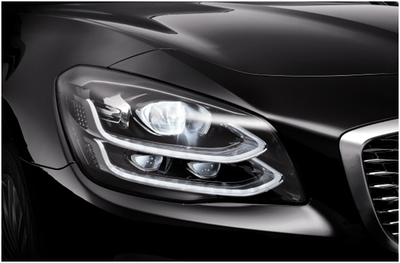SEOUL, South Korea June 25, 2018; Hyundai Mobis announced that it has succeeded in developing new materials that can fundamentally resolve the fog issue that has been a challenge to global lamp makers, and applied it to all its lamp products in production. It also succeeded in reducing the weight of a lamp by 20% by developing and applying new materials for each part of it.
To fundamentally resolve the lamp fog issue, it partnered with INITZ (SK Chemical's subsidiary), which is a Korean materials supplier, and successfully developed a new material that does not emit any gases in just one and a half year after it commenced the project. In this process, it succeeded in the local production of the material that had been entirely imported, and is currently preparing for joint application of patents at home and abroad.
The lamp fog problem occurs when gases generated from the plastic parts inside a lamp are adhered to the wall of the lamp, thus causing it to discolor. This not only negatively affects the appearance of the lamp but it could also threaten safety by deteriorating light distribution. This problem is attributed to the physical properties of plastic that generate gases at a high temperature, and this is not an exception in the headlamps of leading global companies.
All global makers are trying to resolve this issue but they have simply been avoiding the problem by changing the internal structure of a lamp rather than finding a fundamental solution due to the challenging requirements for developing materials.
As a lamp has to endure up to 200℃ of inner temperature and large temperature gaps between the inside and outside of the lamp, it needs to satisfy many requirements, including resistance to humidity and high rigidity to ensure its parts are not shaken by strong vibration.
To satisfy these challenging requirements, Hyundai Mobis added glass fiber to the existing plastic material to secure sufficient rigidity and also added high molecular weight additives, and as a result, it succeeded in developing the new material that satisfies various requirements without generating gases.
Hyundai Mobis completely resolved the fog issue by applying this new material to all its headlamps in production. Unlike other new technologies, material technology can be applied immediately after being developed and offers a huge ripple effect as it can be applied to an entire product line.
Hyundai Mobis also succeeded in developing materials that can reduce the weight of a headlamp, which weighs 5 to 6kg, by as much as 20%. It could reduce the thickness of each part of a headlamp, such as a lens, bezel, reflector and housing, by using materials with good fluidity.
With the development of lightweight materials, the automotive supplier could attain cost reduction and improved lamp functionality. Cost is reduced as thinner parts require less quantity of materials, and the lamp is more resistant to humidity as the plastic materials absorb less moisture.
Hyundai Mobis plans to accelerate its business for global automakers based on its lamp technology that has been upgraded thanks to the new material. As the lamp does not simply provide functionality but it also determines the exterior design of a car, Hyundai Mobis expects that its products that have fundamentally resolved the fog issue would give it an advantage over the global competition.
Hyundai Mobis has been recognized by global automakers for its high-quality lamps, and since 2010, it has recorded a cumulative order amount of $3.4 billion for its lamp products.
"Lamps are applied with such high standards for not only functionality but also aesthetic aspects that even natural condensation caused by physical properties of materials is recognized as a defect," said Kim Se-il, director of Hyundai Mobis Chassis and Outfit R&D Center. "We will spur our technical development to continuously present innovative lamp materials for future cars."
Hyundai Mobis plans to secure various new materials related to lamps, including surface processing technology that reveals hidden patterns and special pigment technology that allows a driver to choose the color of headlamps.
Hyundai Mobis has continued to show distinct results in the lamp material area, which is subject to challenging development requirements, including the world's first hard coating technology it developed in 2016 which protects the lens for a long time under extreme conditions.
Meanwhile, Hyundai Mobis has recently launched the world's longest tunnel test track at its Seosan proving ground and is currently spurring the development of next-generation lamp technologies, securing Intelligent Front-lighting System (IFS) technology or rear lamp technology that features 3D effects.



